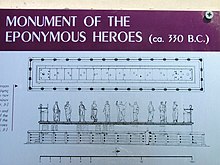
Eleusinion, also called the City Eleusinion was a sanctuary on the lower part of the north slope of the Acropolis in Athens, Greece, dedicated to Demeter and Kore (Persephone). It was the central hub of Eleusinian Mysteries within Athens and the starting point for the annual procession to Eleusis, in the northwest of Attica. Religious activity is attested in the area from the 7th century BC and construction took place throughout late Archaic, Classical, Hellenistic, and Roman periods. The sanctuary was enclosed within the new city walls built after the Herulian sack of Athens in AD 267 and it remained in use until the late fourth century AD.

Eretria is a town in Euboea, Greece, facing the coast of Attica across the narrow South Euboean Gulf. It was an important Greek polis in the 6th and 5th century BC, mentioned by many famous writers and actively involved in significant historical events.

The ancient Agora of Athens is the best-known example of an ancient Greek agora, located to the northwest of the Acropolis and bounded on the south by the hill of the Areopagus and on the west by the hill known as the Agoraios Kolonos, also called Market Hill. The Agora's initial use was for a commercial, assembly, or residential gathering place.
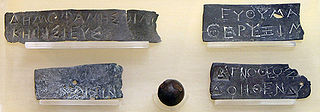
In Ancient Greece, a deme or demos was a suburb or a subdivision of Athens and other city-states. Demes as simple subdivisions of land in the countryside existed in the 6th century BC and earlier, but did not acquire particular significance until the reforms of Cleisthenes in 508 BC. In those reforms, enrollment in the citizen-lists of a deme became the requirement for citizenship; prior to that time, citizenship had been based on membership in a phratry, or family group. At this same time, demes were established in the main city of Athens itself, where they had not previously existed; in all, at the end of Cleisthenes' reforms, Athens was divided into 139 demes. Three other demes were created subsequently: Berenikidai, Apollonieis, and Antinoeis. The establishment of demes as the fundamental units of the state weakened the gene, or aristocratic family groups, that had dominated the phratries.

The Theatre of Dionysus is an ancient Greek theatre in Athens. It is built on the south slope of the Acropolis hill, originally part of the sanctuary of Dionysus Eleuthereus. The first orchestra terrace was constructed on the site around the mid- to late-sixth century BC, where it hosted the City Dionysia. The theatre reached its fullest extent in the fourth century BC under the epistates of Lycurgus when it would have had a capacity of up to 25,000, and was in continuous use down to the Roman period. The theatre then fell into decay in the Byzantine era and was not identified, excavated and restored to its current condition until the nineteenth century.
Phyle is an ancient Greek term for tribe or clan. Members of the same phyle were known as symphyletai, literally: fellow tribesmen. They were usually ruled by a basileus. Some of them can be classified by their geographic location: the Geleontes, the Argadeis, the Hopletes, and the Agikoreis, in Ionia; the Hylleans, the Pamphyles, the Dymanes, in the Dorian region.
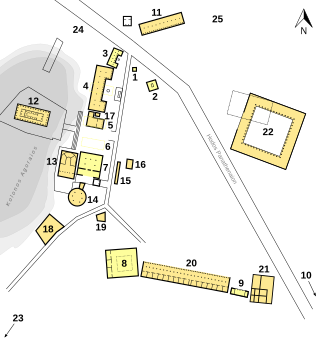
The Stoa Poikile or Painted Portico was a Doric stoa erected around 460 BC on the north side of the Ancient Agora of Athens. It was one of the most famous sites in ancient Athens, owing its fame to the paintings and war-booty displayed within it and to its association with ancient Greek philosophy, especially Stoicism.

Rhamnous, also Ramnous or Rhamnus, was an ancient Greek city in Attica situated on the coast, overlooking the Euboean Strait. Its ruins lie northwest of the modern town of Agia Marina in the municipality of Marathon.

The Arch of Hadrian, most commonly known in Greek as Hadrian's Gate, is a monumental gateway resembling—in some respects—a Roman triumphal arch. It spanned an ancient road from the center of Athens, Greece, to the complex of structures on the eastern side of the city that included the Temple of Olympian Zeus.
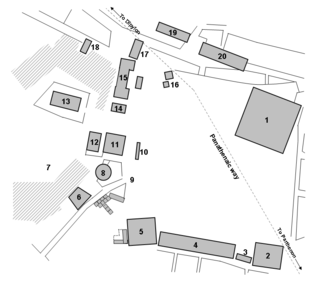
Stoa Basileios, meaning Royal Stoa, was a Doric stoa in the northwestern corner of the Athenian Agora, which was built in the 6th century BC, substantially altered in the 5th century BC, and then carefully preserved until the mid-second century AD. It is among the smallest known Greek stoas, but had great symbolic significance as the seat of the Athenian King Archon, repository of Athens' laws, and site of "the stone" on which incoming magistrates swore their oath of office.

The city of Athens during the classical period of ancient Greece was the major urban centre of the notable polis (city-state) of the same name, located in Attica, Greece, leading the Delian League in the Peloponnesian War against Sparta and the Peloponnesian League. Athenian democracy was established in 508 BC under Cleisthenes following the tyranny of Isagoras. This system remained remarkably stable, and with a few brief interruptions remained in place for 180 years, until 322 BC. The peak of Athenian hegemony was achieved in the 440s to 430s BC, known as the Age of Pericles.

The Altar of the Twelve Gods, was an important altar and sanctuary at Athens, located in the northwest corner of the Classical Agora. The Altar was set up by Pisistratus the Younger, during his archonship, in 522/1 BC. It marked the central point from which distances from Athens were measured and was a place of supplication and refuge.

The Sanctuary of Aphrodite Urania was located north-west of the Ancient Agora of Athens and dedicated to the goddess Aphrodite under her epithet Urania. It has been identified with a sanctuary found in this area in the 1980s. This sanctuary initially consisted of a marble altar that was built around 500 BC and was gradually buried as the ground level rose. Another structure, perhaps a fountainhouse, was built to the west ca. 100 BC. In the early 1st century AD, an Ionic tetrastyle prostyle temple closely modelled on the Erechtheion's north porch, that was built to the north of the altar.

The Temple of Apollo Patroos is a small ruined temple on the west side of the Ancient Agora of Athens. The original temple was an apsidal structure, built in the mid-sixth century BC and destroyed in 480/79 BC. The area probably remained sacred to Apollo. A new hexastyle ionic temple was built ca. 306-300 BC, which has an unusual L-shaped floor plan. Some fragments from the sculptural decoration of this structure survive. The colossal cult statue, by Euphranor, has also been recovered.
Pandion was the eponymous hero of the Attic tribe Pandionis, which was created as part of the tribal reforms of Cleisthenes at the end of the sixth century BC. He is usually assumed to be one of the two legendary kings of Athens, Pandion I or Pandion II.

The Piraeus Athena is a bronze statue dated to the fourth century BCE. It currently resides in the Archaeological Museum of Piraeus.
Ptelea was a deme of ancient Attica of the phyle Oineis, sending one delegate to the Athenian Boule. It is the setting for Menander's Heros.
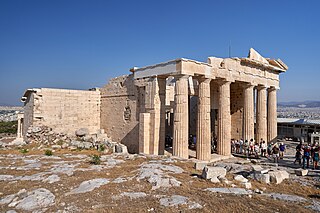
The Propylaia is the classical Greek Doric building complex that functioned as the monumental ceremonial gateway to the Acropolis of Athens. Built between 437 and 432 BCE as a part of the Periklean Building Program, it was the last in a series of gatehouses built on the citadel. Its architect was Mnesikles, his only known building. It is evident from traces left on the extant building that the plan for the Propylaia evolved considerably during its construction, and that the project was ultimately abandoned in an unfinished state.

The Southwest Temple is the modern name for a tetrastyle prostyle Doric temple located in the southwest part of the Ancient Agora of Athens. Fragments from the temple found throughout the Agora enable a full, if tentative, reconstruction of the temple's appearance. These fragments originally belonged to several Hellenistic structures and a fifth-century BC stoa at Thorikos in southeastern Attica, but they were spoliated to build the temple in the Agora in the age of Augustus. It is unknown which god or hero the temple was dedicated to. It was spoliated to build the post-Herulian fortification wall after the Herulian sack of Athens in 267 AD.

The Southeast Temple is the modern name for an Ionic octastyle prostyle temple located in the southeast corner of the Ancient Agora of Athens. Architectural fragments from the temple enable a full, if tentative, reconstruction of its appearance.These fragments originally belonged to the Temple of Athena at Sounion at the southern tip of Attica, but they were spoliated to build the temple in the Agora in the first half of the second century AD. It was thus the last of several "itinerant temples," relocated from the Attic countryside to the Athenian Agora in the Imperial period. It is unknown which god or hero it was dedicated to. It was heavily damaged during the Herulian Sack of Athens in 267 AD and then spoliated to build the post-Herulian fortification wall.


